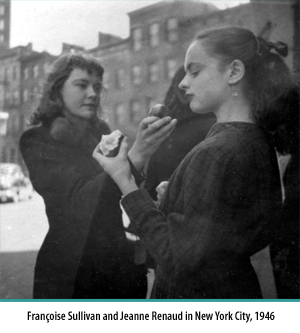| ||||||

In the end, Renaud was in New York for two and a half years, a rich experience as she described it in Les automatistes à Paris : Actes d'un colloque:
In New York, several great modern dancers had impressed and fascinated me - the likes of Martha Graham, Charles Weidman, my teacher Hanya Holm, José Limón, Merce Cunningham - but also George Balanchine in classical ballet who was renewing all the academic dance styles that had preceded him. I was living with my sister Louise in Greenwich Village [later in East Broadway], and we met all kinds of artists - painters, sculptors, musicians, poets - many of whom had left Europe during the war. The atmosphere in New York was tremendously stimulating. Contact between artists was easy and informal, and we worked without counting the hours.
 Her days quickly settled into a routine. Renaud's father sent her $75.00 per month. It was enough to pay for all the dance courses she was taking, but she still needed to earn money for her living expenses. Her sister and Françoise Sullivan had worked at a studio that made displays for department stores and had recommended that Renaud apply. Despite her limited abilities to communicate in English, she was hired. She had difficulty understanding the directions that her boss gave her in English, but by being totally immersed in a foreign language, she learned quickly.
Her days quickly settled into a routine. Renaud's father sent her $75.00 per month. It was enough to pay for all the dance courses she was taking, but she still needed to earn money for her living expenses. Her sister and Françoise Sullivan had worked at a studio that made displays for department stores and had recommended that Renaud apply. Despite her limited abilities to communicate in English, she was hired. She had difficulty understanding the directions that her boss gave her in English, but by being totally immersed in a foreign language, she learned quickly.
After work Renaud would go to her dance classes. While she was in the dressing room getting ready for her first class at Holm's studio, she heard percussion music, which was used by Holm as an accompaniment, emanating from one of the classes. It was, she remembers, unbelievable.
Renaud's cursory grasp of English meant that she had difficulty keeping up with the advanced class she had chosen to attend on her first day. After the class, Holm approached her and suggested that she should take an intermediate class. Although Renaud's pride was somewhat wounded, she followed Holm's advice. While she continued to take a class with Holm once a week, the rest of her classes were taught by Alwin Nikolais and Mary Anthony. Shy, but determined, Renaud asked Holm if she could take private lessons. Holm agreed, but when the eager Renaud arrived at the appointed time, Holm was not there. Instead, Mary Anthony had been assigned to give Renaud a private class. In the end, Renaud enjoyed Anthony's classes so much that she followed her teacher to the New Dance Group, a modern dance company and school that had been established in 1932 by a collective of leftist dancers who stated that they wanted to make “dance a weapon in the class struggle.” The Cold War and anti-Communist sentiments had dampened the political rhetoric in the New York dance community during the 1940s, but the New Dance Group was still a respected studio among modern dancers.
Although she was committed to modern dance, Renaud never renounced ballet. She appreciated the technical foundation ballet classes provided and, even during her time in New York, when there were many dance styles to try and her budget was restricted, she always studied ballet twice a week with Elizabeth Anderson-Ivantovich, a former dancer with the Bolshoi Ballet whose classes in New York attracted many of the city's dance professionals, including ballet dancer Alicia Alonso, modern dancer Daniel Nagrin, and others from the Balanchine company.
The years Renaud spent in New York were important to her development as a modern dance choreographer, not only because she was exposed to the modern dance innovations of the choreographers who made New York their home, but also because the city's museums and vibrant arts community provided an excellent cultural education. The diversity of arts disciplines she encountered was impressive and instructive. Renaud attended dance concerts, music concerts, theatre, galleries, films. She visited museums. She immersed herself in the rich history of the arts and also became conversant in the numerous exciting avant-garde experiments. New York was particularly artistically fertile in the immediate post-World War II years. Many artists who had been at the vanguard of aesthetic innovation in Europe had fled to North America during the war and had made New York the new centre for modernist art. Jeanne's elder brother, Louis, was establishing himself in New York as a photographer, and took photographs of Jeanne dancing her early choreographic works.
It was a friend of Louise and Françoise Sullivan, the now-famous musician Morton Feldman, who was Jeanne's frequent guide to the city, introducing her to artists and musicians, and accompanying her to concerts and museums. Afterwards, Feldman often would take her to a restaurant to discuss what they had seen. In truth, Feldman would do most of the talking and Renaud would listen as her limited English prevented her from fully expressing her thoughts about the recent Beethoven Quartets concert they had heard, or the evening of contemporary music that they had just attended, where John Cage was in the audience. Nevertheless, Renaud quickly developed her own aesthetic preferences. She enjoyed seeing the productions by Martha Graham's company, but knew she did not want to study with the modern dance icon whose technique, she felt, was too codified.
©2009, Dance Collection Danse
Jeanne Renaud Exhibition Curators: Ray Ellenwood and Allana Lindgren
Web Design: Believe It Design Works

